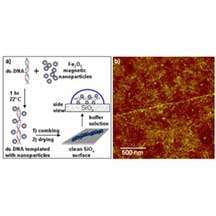Purdue researchers use enzyme to clip 'DNA wires'

Researchers at Purdue University have attached magnetic "nanoparticles" to DNA and then cut these "DNA wires" into pieces, offering the promise of creating low-cost, self-assembling devices for future computers. Findings are detailed in a paper published online in February in the Journal of the American Chemical Society. The paper was written by Purdue graduate student Joseph M. Kinsella and Albena Ivanisevic, an assistant professor of biomedical engineering and chemistry at Purdue.
DNA, or deoxyribonucleic acid, has an overall negative charge, so it might be used in a process called self-assembly to create electronic devices. When placed in a solution with magnetic particles that have a positive charge, the particles are automatically attracted to the DNA strands, which act as tiny scaffolds for creating wires.
Other researchers have "metalized" DNA by coating it with copper, gold and platinum, but no other researchers have coated DNA and then cut the strands into smaller pieces using a "restriction enzyme," a class of enzyme that causes DNA to fragment, Kinsella said.
Because magnetic components are essential for today's computer memory, the findings represent potential future applications for DNA-based structures in computers created with "molecular electronics," in which biological molecules might be harnesses to create devices for computers, sensors and other uses. Self-assembly might be used in the future to create electronic devices at lower cost than is possible with conventional manufacturing processes.
Purdue researchers had previously developed a technique for precisely placing strands of DNA on a silicon chip and then stretching out the strands so that their encoded information might be read more clearly. The current work by Ivanisevic's team builds on that previous research.
Kinsella created the magnetic particles, which are made from a ceramic iron oxide material about 4 nanometers in diameter. A nanometer is one billionth of a meter, or roughly 10 times the size of a hydrogen atom.
The Purdue researchers sliced the DNA wires with an enzyme called BamH1, one of numerous restriction enzymes that are used in standard genetic engineering techniques to snip DNA so that scientists can alter the genetic structures of organisms like bacteria.
DNA molecules contain "bases" called guanine, adenine, thymine and cytosine, represented as G, A, T and C. The bases combine in numerous sequences, and various restriction enzymes attach to and cut specific sequences, enabling scientists to isolate and snip DNA segments of differing lengths. The enzyme used in the Purdue research cuts segments of DNA containing a sequence of GGATCC.
"We incubate the particles and DNA in a solution, and the electric charge brings them together to form the wire," Ivanisevic said. "Then we basically make smaller wire segments with magnetic particles attached to this DNA sequence."
Because hundreds of different restriction enzymes snip segments containing specific sequences of genetic material, the method might be used in the future to cut DNA wires of varying lengths for building electronic devices.
Ivanisevic and former Purdue physics graduate student Dorjderem Nyamjav were the first to coat DNA with magnetic particles two years ago. Kinsella and Ivanisevic are the first to show that the BamH1 enzyme cuts DNA wires.
"We weren't sure the enzyme would be able to recognize the DNA sequence covered with particles," Kinsella said. "We thought the particles might hinder the process."
The researchers found, however, that the particles did not interfere with the process, possibly because the electrical charges are strong enough to hold the particles firmly in place, but weak enough to enable the enzyme to push them out of the way.
"The entire strand of DNA used in this research has been stretched onto silicon oxide surfaces at lengths up to 35 microns, or millionths of a meter, and 2 nanometers wide," Kinsella said. "When coated with particles and fragmented by the enzyme, we were able to distinguish that the once-single DNA wire was clipped into smaller wires."
In future work, the Purdue researchers plan to stretch DNA coated with magnetic particles between electrodes and test the coated genetic material for electrical properties.
Source: Purdue University

















